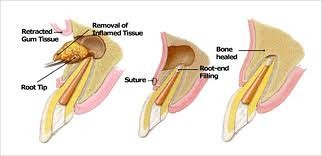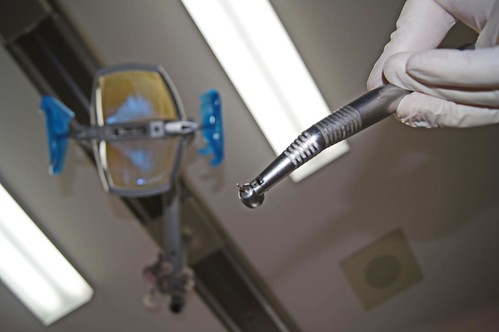 Before the innovations made in modern dentistry, when people had a tooth die at the root, they oftentimes had to suffer through the pain or undergo excruciating trauma in attempting to have the tooth removed. Nowadays, though, there are procedures known as endodontic surgeries that allow dentists to address otherwise painful dental problems and restore patients’ dental health and comfort, in some cases making it possible for them to keep their teeth instead of having to have them totally removed. An apicoectomy is one of the most commonly performed types of endodontic surgeries.
Before the innovations made in modern dentistry, when people had a tooth die at the root, they oftentimes had to suffer through the pain or undergo excruciating trauma in attempting to have the tooth removed. Nowadays, though, there are procedures known as endodontic surgeries that allow dentists to address otherwise painful dental problems and restore patients’ dental health and comfort, in some cases making it possible for them to keep their teeth instead of having to have them totally removed. An apicoectomy is one of the most commonly performed types of endodontic surgeries.
What is an Apicoectomy?
An apicoectomy is a surgical procedure that consists of a tooth’s root being removed. It’s more commonly known as a root end surgery, root resection, a retrograde root canal treatment or root-end filling. It’s not the same thing as a root canal, though. During a root canal, the dentist cleans the canals of your roots using specialized instruments. During an apicoectomy, however, the tip of the root is removed completely along with the infected part of the tissue to prevent any re-infection later and to ensure that the area heals up properly.
How is an Apicoectomy Performed?
Usually, a specialist, known as an endodontist or maxillofacial surgeon, performs an apicoectomy rather than a regular dentist. Before beginning the procedure, they must take various x-rays of the tooth and surrounding bone where the procedure is to be performed. Sometimes the endodotist will prep patients beforehand by giving them an antimicrobial mouth rinse that is designed to help reduce inflammation.
The action surgery begins when the endodontist makes a small incision in the patient’s gum and then lifts the gum away from the affected tooth and bone. If needed, a drill is used to gain access to the root, and then the infected tissue and last few millimeters of the root tip is removed. After removing the apex of the root, then the endodontist utilizes a specialized microscope and ultrasonic instruments to clean the end of the tooth’s canal. Finally, the endodontist takes another x-ray of the area before stitching the tissue of the gums back in place.
Does It Hurt? Contrary to popular belief, apicoectomy procedures aren’t as painful as they are oftentimes portrayed to be. Although there will probably be some discomfort throughout the procedure, local anesthetics tend to make the procedure more comfortable. Additionally, most of the discomfort patients experience occurs after the procedure due to the swelling that sometimes occur during the healing process. This is common for nearly any type of surgical procedure, though, and endodontists usually prescribe patients with the appropriate pain medications to alleviate pain as well as antibiotics to help reduce swelling.
Contrary to popular belief, apicoectomy procedures aren’t as painful as they are oftentimes portrayed to be. Although there will probably be some discomfort throughout the procedure, local anesthetics tend to make the procedure more comfortable. Additionally, most of the discomfort patients experience occurs after the procedure due to the swelling that sometimes occur during the healing process. This is common for nearly any type of surgical procedure, though, and endodontists usually prescribe patients with the appropriate pain medications to alleviate pain as well as antibiotics to help reduce swelling.
References:
Grossman I, Abu el Naag A, Peled M. “[Root-end filling materials in apicoectomy–a review].” Retrieved on October 7, 2015, from http://www.ncbi.nlm.nih.gov/pubmed/12830493 .
The United States National Library of Medicine National Institutes of Health
8600 Rockville Pike,
Bethesda MD, 20894 USA
1-888-FIND-NLM
http://www.ncbi.nlm.nih.gov
Images:
https://farm9.staticflickr.com/8231/8382959907_352f97dd05.jpg
https://farm6.staticflickr.com/5247/5370313957_34ec7579ec.jpg